INTRODUCTION
What is mathematics? Is it calculation? Is it logic? Is it symbols? Pictures? Graphs? Turns out, it is all of these and so much more. IT IS BUT A LANGUAGE. The universal language, having its symbols, characters, expressions, vocabulary, grammar, everything that makes a language, all perfectly reasoned, unique and unambiguous in their meaning. It is the language in which the laws of the universe are written. Hence it is the language we must learn and explore to unravel the mysteries of nature. We must begin our discussion on one of the most beautiful and fundamental mathematics topics, FUNCTION THEORY, with this philosophy.
WHAT ARE EXPRESSIONS, EQUATIONS AND, IDENTITIES?
Like all well-defined languages, mathematics comes with its own set of symbols and characters, numeric and alphabetical. An expression in mathematics is a combination of such symbols and characters. These all will be explain in this function theory discussion.
5+2/(9-3)
7a+2b-3c
2 cos 1/2 (α + β) cos 1/2 (α – β)
These are all mathematical expressions. No matter if they could be evaluated or not, if they are meaningful and if they follow proper syntax, they are expressions.
Now, when we compare two expressions with an ‘=’ sign, we have something like …
(1+x)2 = 1+2x+x2
Which is an expression for equality of two expressions written on either side of an = sign. Note, that this equality is true for all values of x. These sorts of equalities are called IDENTITIES.
(1+x)2 = 2+3x+2x2…………..(1)
Or like
(1+x)2 = 7-3x+2x2…………(2)
Then they won’t be true for all values of x, rather they would be true for some values of x like (2) or they would be true for NO values of x, like (1). These are called EQUATIONS.
So to summarize, equalities that have for all values of the variables, are IDENTITIES. And equalities that hold for some or no values of the variables are EQUATIONS.
WHY DO WE NEED THE CONCEPT OF FUNCTION?
Is it not amazing that the universe is so perfectly balanced? A system of such enormous size made of so many smaller systems, each having so many variables interacting with each other, yet so well behaved. Does it not seem that everything is governed by a set of rules, unseen but existing everywhere? Take the example of the gravitational force. It is inversely proportional to the distance between bodies, and this rule is followed by all matters, everywhere in the universe. So, we must have a way to express such rules, such as connections between variables.
We are surrounded by such variables which depend on other variables. The length of the shadow of a building depends on its height and the time of the day. The distance travelled by car depends on the torque generated by its engine. It is the concept of function theory that enables us to express such relations mathematically.
SO WHAT IS A FUNCTION IN MATH?
Function Rule or FUNCTION as a rule
To put it simply, a function is a rule that binds two or more variables. If the variables are allowed to take only real values then it is simply an expression that defines a rule or a set of rules that assigns a real number to each of certain real numbers.
Now this definition surely requires some clarification which are given through the examples such as
1. The rule that assigns the cube of that number to each number.
f(x) = x3
2. The rule that assigns (x2-x-1)/x3 to each x
f(x) = (x2-x-1)/x3
3. The rule that assigns (x2–x-1)/(x2+x+1) to all x which are not equal to 1 and the number 0 to 1
f(x) = (x2-x-1)/(x2+x+1) for x ≠ 1
= 0 for x=1
- f(x) = x2
for -1 < x < π/3
- The rule that assigns
2 to number 5
3 to number 8/3
π/2 to number 1
and to the rest
- The rule that assigns to a number x, the number of 1s in its decimal expansion if the count is finite and 0 if there are infinitely many 1s in the expansion.
These examples should make one thing very clear that a function is any rule that assigns numbers to specific other numbers. These rules may not always be expressible by algebraic formulation. These may not even point to one unique condition that applies to all numbers. And it doesn’t have to be a rule that one can find in practice or in the real world, like the one in rule 6. No one can tell which number this rule assigns to the number π or √2. The rule also may not apply to some numbers. For example, rule 2 does not apply to x=0. The set of numbers to which the rule applies is called the DOMAIN of the function.
SO WHAT DOES y= f(x) MEAN?
Note, that we are using the expression y=f(x) to write a function. Whenever we start an expression with ‘f(x) = y’ then we mean that we are about to define a function that relates a set of numbers with a set of values of the variable x.
FUNCTION as a relation
So, in other words, and perhaps in a more general sense, a function is a relation between two sets A and B, where all the elements in the set A have an element assigned to them from the set B. The elements from set B are called the IMAGES and the elements of set A are called the PRE-IMAGES.
The process of relating the elements is called MAPPING. Of course there could be many ways in which these mappings can be done, but we would not call all of them as functions. Only those mappings that relate the elements in such a way that every element in set A has exactly one image in set B, are to be called functions. It is sometimes written as f : A–> B . This is to be read as ‘f is a function from A to B’.
The set A is called the DOMAIN of the function and the set B is called the CO-DOMAIN of the function. If f is such that the image of one element a of set A is the element b from set B, then we write f(a) = b, read as ‘f of a is equal to b’, or ‘b is the value of f at a’, or ‘b is the image of a under f’.
TYPES OF FUNCTIONS
Functions may be classified as per the way they relate the two sets.
One – one or injective function
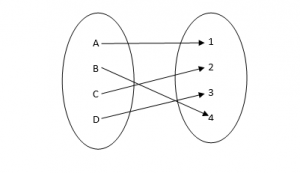
The figure says it all. It is when a function relates every element of a set to a unique element of another set, it is a one to one or injective function.
Many – one function
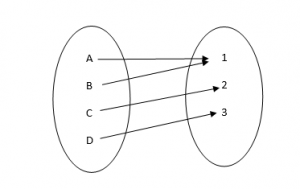
Again, the figure is quite self-explanatory. Evidently there are more than one pre-image to a particular image. Hence the mapping is many to one. Note, that it does not violate the definition of a function as no element from set A has more than one image in set B.
ONTO function or SURJECTIVE function
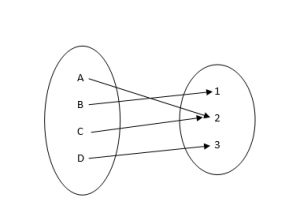
When all the elements of set B has at least one pre-image, then the function is called Onto or surjective. Onto mapping can be one to one or many to one. The one depicted above is evidently many to one onto mapping. Note that the picture used previously for depicting one to one mapping is also onto mapping. This sort of one to one onto mapping is also known as BIJECTIVE mapping.
Into function
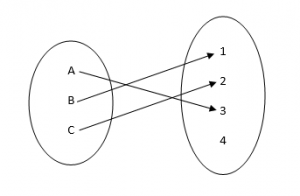
When there is at least one image without any pre-image, it is an INTO function. Into function can be one to one or many to one. The one depicted above is obviously one to one into.
GRAPH OF A FUNCTION
As it is said earlier that a function assigns real numbers to certain real numbers, it is quite possible and convenient to plot the pair of numbers on X-Y Cartesian plane. The trace obtained by connecting the points, is the graph of the function.
Let us consider a function f(x) = x + 3. Then, we could evaluate f(x) at x=1,2,3 to obtain three pairs of x and f(x) as (1,4) , (3,6) and (5,8). Plotting these points and connecting them shows that the function traces a straight line in the x-y plane. This line is the graph of the function.
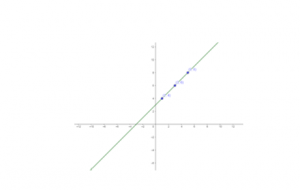
Evidently, the nature of the trace will vary according to the expression for the function. Thus we get a range of graphs for different kind of expressions. A few are given.
The graphs of f(x) = sin x, f(x) = x2 and f(x) = ex from left to right
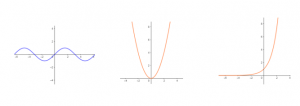
At this point, one can see that the expression for a function actually looks like that of an equation. And it is true, for example y = x + 3 is indeed an equation as well as a function definition. This brings us the question, are all equation functions? If not then
How to tell if an equation is a function?
All the equations depicted in the graphs earlier are actually functions, as for all of those, there is exactly one value of f(x) or y for some value of x. This means that the expression for f(x) should yield only one value when evaluated for any value of x. This is true for any linear equation. But if we consider the equation y2 = 1-x2, we find that there are always two solutions for all x within 0 to 1, in other words, two images are assigned to each value of x within its range. This violates the definition of a function and hence cannot be called a function.
This should look clearer from the graph that there are exactly two images of each x as a vertical line drawn at any point on the x axis will cut the graph at exactly two points.
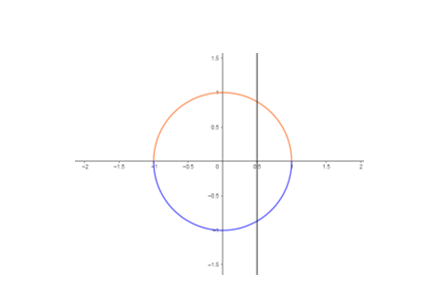
So, this brings us to one important conclusion that not all equations are functions. And whether an equation is a function, can be verified by the vertical line test, which is simply imagining a variable vertical line at each point on x axis and seeing if it meets the graph at a single point.
This also answers another important question, which is, how to tell if a function is one to one? Surely enough, that answer is also in the graph and can be verified by the vertical line test.
Now, one could ask if there is a way to tell the same without obtaining the graph or if it could be told algebraically as it is not always easy to draw graphs of functions. Well the answer is yes, it can be done simply by testing f(a)=f(b) implies a=b. This is to say that even if f(x) takes the same value for two values of x, then the two values of x cannot be different. Let us take an example of the function
y=(x-1)/(x-2)
As one would notice that it is difficult to plot the graph of this function as it is non-linear in nature and does not fit the description of any familiar curve and moreover is not defined at x=2 . So, this problem definitely calls for a different approach from the vertical line test.
So, we begin by letting
f(a)=f(b)
=> (a-1)/(a-2)=(b-1)/(b-2)
=>(a-1)(b-2)=(b-1)(a-2)
=>ab-2a-b+2=ab-2b-a+2
=> 2a+b=2b+a
=>2(a-b)=(a-b)
This is only possible for a-b=0 or a=b
So, the function is indeed one to one, and we have proved it without graphing.
Now, we would want to see when some function fails this test. We might want to test equation of the circle we tested before. We start by writing
f(a)=f(b)
f(x) = x2
=> a2=b2
a2 =b2
=> a=b or a=-b
Which simply means that there are solutions other than a=b, hence f(x) is not a function.
IS IT SO DIFFICULT TO PLOT y=(x-1)/(x-2) ?
We are going to discuss graphing of a function in much greater detail in the upcoming articles but here it is necessary to get familiar with the basics of graphing as it helps immensely with problem solving. A visual interpretation of a calculus problem often makes the problem very easy and knowing how to graph a function is the key to a good visual interpretation.
So, to plot the graph of (x-1)/(x-2), we begin by making a few critical observations such as
1. The function becomes 0 at x=1.
2. The function becomes undefined at x=2 .
3. The function is positive everywhere except for 1<x<2.
Because in this interval (x-1) is positive and (x-2) is negative, this makes their ratio negative.
4. As x goes to -∞ the function nears unity from the lower side, meaning that it goes close to 1 but is always less than 1.
Because for x<0, (x-1)/(x-2) =(|x|+1)/(|x|+2)<1 as |x|+2>|x|+1
5. As x goes to +∞ the function nears unity from the upper side, meaning that it goes close to 1 but is always greater than 1.
6. As x goes to 2 from the left side, the function goes to -∞.
7. As x goes to 2 from the right side, the function goes to +∞.
8. The function is always decreasing for x>2.
PROOF:
We take two close values of x as (a, b) such that (a, b) >2 and b>a
now, f(b) – f(a)
=(b-1)/(b-2)-(a-1)/(a-2)
={(b-1)(a-2)-(a-1)(b-2)}/(a-2)(b-2)
=(a-b)/{(a-2)(b-2)}
<0 as (a-b)<0 for b>a
and (a-2)(b-2)> 0 as (a, b)> 2
This implies f(b)<f(a) for all a>2, in other words f(x) is strictly decreasing for x>2
- 9. The function is always decreasing for x<2
- PROOF: same as before. We leave it for you to try.
Combining these observations makes the graphing quite easy. Combining 4,9 and 6 we can say that as x goes from -∞ to 2, the trace starts from unity and falls gradually to touch 0 at x=1 and falls further to -∞ at x=2. Again combining 7,5 and 8 it is easy to see that as x goes from 2 to +∞, the trace starts falling from +∞ and keeps getting close to unity never really touching it.
This makes the complete graph look like
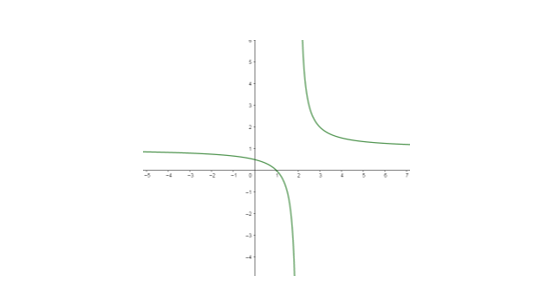
Now it becomes evident that the function is indeed one to one.
CONCLUSION
So far we discussed the basics of function theory. We should be now clear on the definitions and types of functions. We also had a little idea of graphical interpretation of functions. Next article will be covering a lot more detail on concepts such as range and domain, inverse functions, various functions and their graphs, and a lot of worked out problems. To go deeper into the study, you are encouraged to read
Calculus by Michael Spivak.
Algebra by Michael Artin.
For more mathematics article, please click here.

The lambdageeksScience Core SME Team is a group of experienced subject matter experts from diverse scientific and technical fields including Physics, Chemistry, Technology,Electronics & Electrical Engineering, Automotive, Mechanical Engineering. Our team collaborates to create high-quality, well-researched articles on a wide range of science and technology topics for the lambdageeks.com website.
All Our Senior SME are having more than 7 Years of experience in the respective fields . They are either Working Industry Professionals or assocaited With different Universities. Refer Our Authors Page to get to know About our Core SMEs.